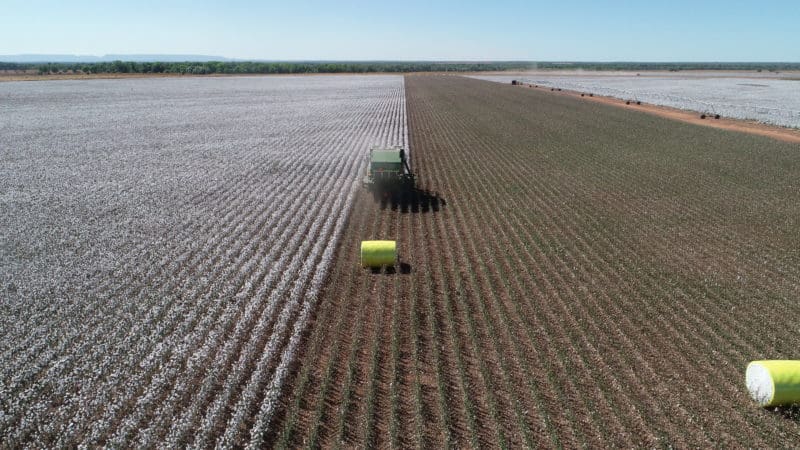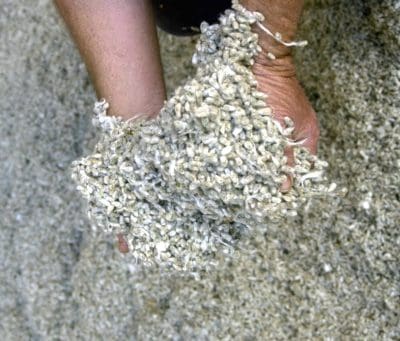
An NT court case will question whether Auvergne Station’s land clearing for cotton falls under “pastoral purpose” classification. Others, like Tipperary Station cleared land under the stricter “non-pastoral use” header. Photo: Tipperary Station.
TWO NORTHERN Territory advocacy organisations have launched landmark legal action in the NT Supreme Court, which they hope will have the potential to impact how growers obtain land-clearing permits to produce cotton.
Case outcomes are expected to provide clarity around the permit system and could potentially call into question the validity of several other land-clearing permits.
The proceedings have been initiated separately by the Northern Land Council and the Environment Centre NT.
They relate to an NT Pastoral Land Board decision to permit Vietnamese-owned corporation Clean Agriculture and International Tourism to clear 932ha at Auvergne Station in the Victoria River region.
In the permit application, the company signaled its intention to use 249ha of the cleared land for a trial cotton crop.
Granted in November 2022, the application was made under the “pastoral purposes” classification, which historically incorporated land clearing for fodder crops or improved pastures.
Generally used for other developments such as horticulture, tourism and aquaculture, the “non-pastoral purposes” classification requires applicants to undertake more rigorous environmental assessments and consult with traditional owners.

ECNT executive director Kirsty Howey.
ECNT is arguing that pastoral-purpose applications are currently being fast-tracked by the NT Pastoral Land Board.
Lakefield Station and Tipperary Group’s Tipperary East Station applied for land clearing permits as a non-pastoral use prior to planting cotton.
Others, like Auvergne Station, opted to use the pastoral purpose classification.
These cases include the application to clear 1995ha of land at Scott Creek Station by Argentinian-owned Cross Pacific Investments, which is currently under assessment, and Cleveland Agriculture’s approved application to clear 4898ha Ucharonidge Station.
Both applicants are expected to argue that land clearing for cotton crops falls under that non-pastoral purposes header.
However, the groups’ approaches are expected to differ slightly.
NLC will most likely assert that more consultation with traditional owners is required, and ECNT is expected to argue that cotton cropping requires more environmental assessments than fodder crops and grazing.
“One of our issues is that we are seeing this increase in land clearing and land clearing permits being issued for cotton and we don’t believe it is consistent with the purposes of the Pastoral Land Act,” ECNT executive director Kirsty Howey said.
“It is really important that this is tested because it has huge significance for the nature of the NT and for the advance of the cotton industry.”
Importance of cottonseed
Cottonseed is a by-product of the ginning process, and a high-protein food source for livestock.
It is widely used in other parts of Australia, and overseas, to supplement pasture, hay and grain diets for cattle, particularly in dry times.
A document compiled by PWC for NT Farmers and NT Government argued that having locally produced cottonseed meal would “promote the intensification of the Northern Territory beef and grazing industry which has been lacking protein sources”.
 Environmental Justice Australia lawyer Laura Dreyfus is part of the team representing ECNT, and suggested this argument was a red herring.
Environmental Justice Australia lawyer Laura Dreyfus is part of the team representing ECNT, and suggested this argument was a red herring.
“The cotton industry in NT appears to be saying in some resources that you can feed the cottonseed to the cattle,” Ms Dreyfus said.
“So, in some ways there is a connection to the pastoral estate, if you are feeding the cottonseed to the cattle.
“It is pretty unlikely that you are going to make most of the money from feeding the seed to the cattle as opposed to…selling the lint.
“In this case, we haven’t seen much indication to say that here there are plans to feed the seed to the cattle at [Auvergne] station.”
The seed grown in NT cotton cannot be used by the local cattle industry as it is too expensive to transport the material north after it is ginned in southern Queensland.
An NT gin, currently under construction, would change this situation and allow cottonseed to remain in the local area.
Will it impact cotton’s expansion?
If the case is successful, there is no guarantee that it will slow the growth of the cotton industry in NT.
Several land clearing permits for cotton crops have been approved under the non-pastoral use category.
Also, the pastoral use land clearing application for Ucharonidge Station was referred to the NT Environmental Protection Authority in September 2021 for further consideration.
The NT EPA found that “proposed action does not have the potential to have a significant impact on the environment” and therefore didn’t require an environmental impact statement.
This may provide a precedent that extra environmental assessments aren’t required by government bodies for cotton developments.
Both sides want sustainability, consultation
Statements from NLC and ECNT have suggested that both groups are not against any cotton development in the NT and instead want the industry to grow sustainably, with proper scrutiny and under consultation with traditional owners.
“The NLC is not opposed to development, but it must be done in a sustainable and respectful way,” NLC chief executive officer Joe Martin-Jard said.
“It’s not good enough that Aboriginal Territorians with legal rights on country subject to pastoral leases have no opportunity to have their voices heard before land clearing is permitted.”
Supporters of the industry, NT Farmers, Northern Cotton Growers Association and Cotton Australia also want cotton production to be done incrementally and with the supervision of the NT government.
“The NT Government has an approval process in place regarding cotton growing and as an industry we respect those processes and will comply with them,” a spokesperson for Cotton Australia said.
“The NT government is proposing the sustainable development of selected precincts, in line with its objective to grow plant-based agriculture’s economic contribution.”
This season NT growers planted approximately 10,000ha of cotton crops.
The industry has suggested that the state has enough suitable land to support up to 200,000ha.
Grain Central: Get our free news straight to your inbox – Click here



HAVE YOUR SAY